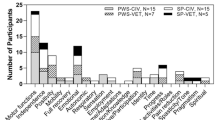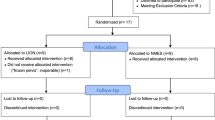Abstract
Study Design:
A longitudinal retrospective study.
Objective:
To better understand individual-level temporal change in functional status for participants with paraplegia in the National Spinal Cord Injury Database (NSCID), as measured by Rasch Transformed Motor Functional Indepedence Measure (FIM) scores.
Setting:
Multicenter/Multistate longitudinal study across the United States.
Methods:
Non-linear random effects modeling, that is, individual growth curve analysis of retrospective data obtained from the National Institute on Disability and Rehabilitation Research (NIDRR) NSCID.
Results:
We generated non-linear individual level trajectories of recovery for Rasch Transformed Motor FIM scores that rise rapidly from inpatient rehabilitation admission to a plateau. Trajectories are based on relationships between growth parameters and patient and injury factors: race, gender, level of education at admission, age at injury, neurological level at discharge, American Spinal Injury Association Impairment Scale (AIS) at discharge, days from injury to first system inpatient rehabilitation admission, rehabilitation length of stay, marital status and etiology. On the basis of study results, an interactive tool was developed to represent individual level longitudinal outcomes as trajectories based upon an individual’s given baseline characteristics, that is, information supplied by the covariates and provides a robust description of temporal change for those with paraplegia within the NSCID.
Conclusions:
This methodology allows researchers and clinicians to generate and better understand patient-specific trajectories through the use of an automated interactive tool where a nearly countless number of longitudinal paths of recovery can be explored. Projected trajectories holds promise in facilitating planning for inpatient and outpatient services, which could positively impact long term outcomes.
Similar content being viewed by others
Log in or create a free account to read this content
Gain free access to this article, as well as selected content from this journal and more on nature.com
or
References
Backus D, Gassaway J, Smout RJ, Hsieh CH, Heinemann AW, DeJong G et al. Relation between inpatient and postdischarge services and outcomes 1 year postinjury in people with traumatic spinal cord injury. Arch Phys Med Rehabil 2013; 94 (4 Suppl): S165–S174.
Horn SD, Smout RJ, DeJong G, Dijkers MP, Hsieh CH, Lammertse D et al. Association of various comorbidity measures with spinal cord injury rehabilitation outcomes. Arch Phys Med Rehabil 2013; 94 (4 Suppl): S75–S86.
Wilson JR, Grossman RG, Frankowski RF, Kiss A, Davis AM, Kulkarni AV et al. A clinical prediction model for long-term functional outcome after traumatic spinal cord injury based on acute clinical and imaging factors. J Neurotrauma 2012; 29: 2263–2271.
Singer J, Willett J . Applied Longitudinal Data Analysis. Oxford University Press Inc.: Oxford. 2003.
Kozlowski AJ, Pretz CR, Dams-O'Connor K, Kreider S, Whiteneck G . An introduction to applying individual growth curve models to evaluate change in rehabilitation: a National Institute on Disability and Rehabilitation Research Traumatic Brain Injury Model Systems Report. Arch Phys Med Rehabil 2013; 94: 589–596.
Pretz CR, Kozlowski AJ, Dams-O’Connor K, Kreider S, Cuthbert JP, Corrigan JD et al. Descriptive modeling of longitudinal outcome measures in traumatic brain injury: a National Institute on Disability and Rehabilitation Research Traumatic Brain Injury Model Systems Study. Arch Phys Med Rehabil 2013; 94: 579–588.
Pretz CR, Dams-O’Connor K . Longitudinal Description of the Glasgow Outcome Scale-Extended for Individuals in the Traumatic Brain Injury Model Systems National Database: a National Institute on Disability and Rehabilitation Research Traumatic Brain Injury Model Systems Study. Arch Phys Med Rehabil 2013; 94: 2486–2493.
Pretz CR, Malec JF, Hammond FM . Longitudinal Description of the Disability Rating Scale for Individuals in the National Institute on Disability and Rehabilitation Research Traumatic Brain Injury Model Systems National Database. Arch Phys Med Rehabil 2013; 94: 2478–2485.
Kozlowski AJ, Heinemann AW . Using individual growth curve models to predict recovery and activities of daily living after spinal cord injury: an SCIRehab project study. Arch Phys Med Rehabil 2013; 94 (4 Suppl): S154–S164.
Bode RK, Heinemann AW, Kozlowski AJ, Pretz CR . Self-scoring templates for motor and cognitive subscales of the Functional Independence Measure for persons with spinal cord injury. Arch Phys Med Rehabil 2013; 95: 676–679.e5.
Whiteneck GG, Gassaway J . SCIRehab uses practice-based evidence methodology to associate patient and treatment characteristics with outcomes. Arch Phys Med Rehabil 2013; 94 (4 Suppl): S67–S74.
Linacre JM, Heinemann AW, Wright BD, Granger CV, Hamilton BB . The structure and stability of the Functional Independence Measure. Arch Phys Med Rehabil 1994; 75: 127–132.
Warschausky S, Kay JB, Kewman DG . Hierarchical linear modeling of FIM instrument growth curve characteristics after spinal cord injury. Arch Phys Med Rehabil 2001; 82: 329–334.
Kirshblum SC, Burns SP, Biering-Sorensen F, Donovan W, Graves DE, Jha A et al. International standards for neurological classification of spinal cord injury (revised 2011). J Spinal Cord Med 2011; 34: 535–546.
DeVivo MJ, Jackson AB, Dijkers MP, Becker BE . Current research outcomes from the Model Spinal Cord Injury Care Systems. Arch Phys Med Rehabil 1999; 80: 1363–1364.
Chen Y, Deutsch A, DeVivo MJ, Johnson K, Kalpakjian CZ, Nemunaitis G et al. Current research outcomes from the spinal cord injury model systems. Arch Phys Med Rehabil 2011; 92: 329–331.
Stover SL, DeVivo MJ, Go BK . History, implementation, and current status of the National Spinal Cord Injury Database. Arch Phys Med Rehabil 1999; 80: 1365–1371.
Acknowledgements
This work was funded by the National Institute on Disability and Rehabilitation Research (NIDRR) Traumatic Brain Injury Model Systems National Data and Statistical Center (Grant Number H133A110006), the National Spinal Cord Injury Statistical Center (Grant Number H133A110002) and the National Institutes of Health through the Center for Rehabilitation Research using Large Datasets (Grant Number R24-HD065702). This work was prepared at the Traumatic Brain Injury Model Systems National Data and Statistical Center, Englewood CO and at the National Spinal Cord Injury Statistical Center University of Alabama at Birmingham, Birmingham, AL, USA.
Author information
Authors and Affiliations
Corresponding author
Ethics declarations
Competing interests
The authors declare no conflict of interest.
Additional information
Supplementary Information accompanies this paper on the Spinal Cord website
Supplementary information
Rights and permissions
About this article
Cite this article
Pretz, C., Kozlowski, A., Charlifue, S. et al. Using rasch motor FIM individual growth curves to inform clinical decisions for persons with paraplegia. Spinal Cord 52, 671–676 (2014). https://doi.org/10.1038/sc.2014.94
Received:
Revised:
Accepted:
Published:
Issue date:
DOI: https://doi.org/10.1038/sc.2014.94



